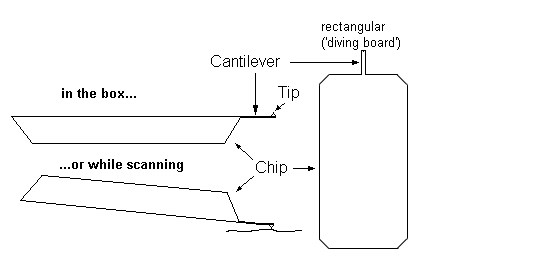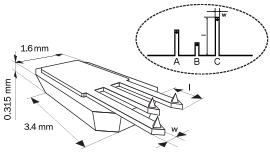Frequently Asked Questions
General
Since November 2012 all MikroMasch SPM probes are being manufactured with the new HQ (High Quality) AFM probe technology. The pricing is kept at the same inexpensive level that our customers appreciate for many years.
HQ is the next generation of MikroMasch AFM probes distinguished by its high quality and high repeatability of characteristics. In particular, the AFM probes have much more consistent reflectivity of the uncoated AFM cantilevers, AFM tip radius and quality factor compared to our former standard AFM probes. The HQ AFM probe chips have cut corners that allow them to be used at an angle from the vertical.
The nominal characteristics of the new high quality HQ AFM probes are kept the same or as close as possible to the former standard MikroMasch product line.
The main advantages of the HQ AFM probes are: HQ - High quality and consistency Tip sharpness better than 10 nm* High Q-factor and smooth resonance curves Ideal reflectivity from the backside of the AFM cantilever For the old non-HQ price
Please, check out our screencast on High Quality Line SPM Probes here .
The order codes of all AFM probes are changed adding an “HQ” in front of the former order codes to reflect this significant improvement. Certain products are replaced with completely improved product versions.
*In 95% of the cases. AFM tip coatings increase tip radius.
AFM (Atomic Force Microscopy) is a widely-used instrument and technique for non-destructive surface investigations as well as for surface modifications at the nanoscale. Besides topography, AFM is capable of collecting information that relates to local material properties such as adhesion, stiffness, elasticity, conductivity, coercitivity, etc.
The principle of AFM consists in registering the force experienced by the AFM probe from the sample as the AFM probe scans its surface. There are other scanning techniques like STM or NSOM, where the AFM probe is designed to register other physical values. All these techniques and instruments are referred to as SPM (Scanning Probe Microscopy). So AFM is a part of SPM.
AFM is a widely used technique in life science, chemistry and materials research, where the structures and processes at micro and nanoscale are of interest.
MikroMasch offers AFM probes and test structures.
The AFM probe is a key part of any AFM experiment. One of the most important characteristics of an AFM probe is its sharpness, that determines the resolution. Extremelly sharp AFM probes with subnanometer radius can provide true submolecular resolution in ambient conditions. Any AFM probe also has to provide means to transfer the force signal to the AFM system.
The test structures provide means to check the system performance in many aspects. In combination with special techniques, the test structures can be used for calibration purposes.
Basically a chip is a relatively large piece of silicon to which one or several AFM cantilevers are attached (see Fig.). AFM cantilevers (or just levers) are thin beams of silicon or silicon nitride. They usually have rectangular or triangular shape and well-defined mechanical properties. Finally, an AFM tip is a very sharp protrusion at the end of an AFM cantilever, although AFM cantilevers themselves are often referred to as 'tips' as in 'contact tips', for example.

Our AFM probes are compatible with the microscopes of all major SPM manufacturers, including Bruker (Veeco, Digital Instruments, ThermoMicroscopes), Agilent, Asylum Research, JEOL, PSIA, Burleigh, and others. Note that to use AFM cantilevers in ThermoMicroscopes SPM you need to mount them first.
The dimensions of the chip are 1.6 mm x 3.4 mm x 0.3 mm.
If you want to order our AFM probes, we will ship them to you. We still await our first order from Antarctica. Other than that we receive orders from pretty much everywhere around the globe.
You can place an order directly online through our online store. Alternatively, you can call or email our distributor closest to you. Here is a list of our distributors.
Certainly! Call us today to help you identify the most suitable AFM probe for your application and we will make sure that you can test it before you buy it.
Mikromasch Mix&Match box is available for those of our customers who want to make their custom selection from a variety of different AFM probes in smaller quantities while still making use of the huge built-in discounts for our large boxes. Selections with 100 to 400 AFM probes are available with discounts of up to 40%. To learn more click here.
Please contact MikroMasch tech support team using our request form .
AFM Probes
We use monocrystalline silicon for manufacturing AFM cantilevers.
The sample facing side of the AFM cantilevers is a (100) plane and the AFM cantilevers point in the direction.
Young's modulus of elasticity E = 1.69*1011 N/m2 (in the direction)
Shear modulus G = 0.5*1011 N/m2
Density = 2330 kg/m3
Our AFM cantilevers are n-doped. The specific resistance of the doped silicon material is 0.01-0.025 Ohm*cm. However, in air, silicon always has a native oxide layer, which is not conductive. You can try to remove it in UHV and use the AFM cantilevers in UHV immediately, because in air the native SiO2 layer will grow again very soon. You can also purchase AFM cantilevers with conductive coating like Pt.
Our AFM probes are available with different coating options: aluminum reflex coating, gold reflex coating, diamond-like-carbon AFM tip coating, cobalt-chromium magnetic AFM tip coating as well as the electrically conductive gold overall coating and platinum overall coating.
The thickness of the native oxide layer is about 1 - 2 nm.
Reflective coating is deposited on the backside of AFM cantilevers to increase the reflected laser signal and prevent interference of light reflected from the two surfaces of the AFM cantilever (silicon is semi-transparent, so some portion of the incident beam is reflected from the backside, and some from the tip side). The most popular reflective coatings are gold and aluminum. A reflective coating is not used when AFM cantilever already has another type of overall coating (for example conductive).
Important! Use uncoated or gold coated AFM cantilevers whenever experimental conditions may lead to corrosion of the reflective coating.
To answer your question, we removed coatings from different AFM cantilevers. Typically, after removal the frequency goes down very slightly. For example, for HQ:CSC17 series AFM probes the difference in the frequencies of coated and uncoated AFM cantilevers is in the order of 30 - 50 Hz (the fundamental frequency is about 13 kHz).
Our HARD series features AFM probes with a thin but robust diamond-like-carbon (DLC) coating that enhances AFM tip life without significantly sacrificing resolution.
MikroMasch Hi’Res-C series AFM probes are long-term leaders among supersharp AFM probes. The diamond-like spikes grown on top of the standard silicon AFM tips have a typical radius of curvature of only 1nm!
The AFM cantilever does not behave like harmonic oscillator and its spectrum has additional resonance peaks at higher frequencies. These peaks can be assigned to different oscillation modes of the AFM cantilever or even oscillations of the microscope head.
If you use autotune, you probably see a resonance of high order. Try manual tune and limit the range of scanning frequencies.
The elastic modulus of Si changes as a function of temperature, which brings about the variation of the resonance frequency. The composition of the atmosphere is also crucial when you are talking about such precision. In the case the difference in gas density and friction influences the Q-factor and the shift of the resonance frequency with respect to that in vacuum.
A: Some of our chips have more than one AFM cantilever. In this case, instead of calling them "left short AFM cantilever" or "middle long AFM cantilever" we use one-letter names. The letters by themselves do not have any meaning, refer to the description of a specific series for specifications.

The package sizes of our AFM cantilevers are 5, 15, 50, 100, 200 and 400. Not all AFM cantilevers are offered in all package sizes. Please check the available package sizes for the specific model of interest to you on its webpage.
How to use
It is not necessary. Although you cannot control the force applied by the lever you are not using, in most cases nothing will happen to it and you will be able to use it later (e.g. by realigning the laser).
Unfortunately, this important question does not have a simple answer. A lot will depend on the properties of your sample and imaging conditions and there is often a trade-off of some sort. Here are a couple of general remarks.
In contact mode soft AFM cantilevers should be used to minimize damage to the sample and the AFM tip. However, very soft AFM cantilevers are noisy.
In tapping mode stiff AFM cantilevers are used so that the AFM tip does not stick to the sample surface. AFM cantilevers with very high resonance frequencies (and force constants) allow faster scanning but can damage very soft samples. Rectangular AFM cantilevers are preferable because they typically have better Q-factors than triangular ones.
Basic techniques and recommended types of AFM cantilevers for different SPM applications are described in our "How-to-choose" chapter.
We do offer contact mode AFM probes with hard DLC coated AFM tips ( HQ:CSC17/Hard/Al BS ). However, the coating is very thin in order to keep tip radius low. Therefore, we do not recommend this model for scratching hard surfaces.
The best choice will be Hi'Res-C AFM probes, which have a curvature radius of about 1 nm. The choice of the force constant of the AFM cantilever basically depends on the mechanical and adhesion properties of your sample. As the AFM probe is very sharp, it requires special care in use, especially in engagement procedure. Our experience shows that many users break the AFM tips during the first tests.
Yes. Try the HQ:NSC36/Cr-Au BS AFM probes. These AFM cantilevers are the shortest and suffer the least dumping forces in liquid media. Corresponding resonance peaks (10 - 35 kHz in water) are clearly seen in an AFM cantilever tune.
We produce the PA01 test sample for this purpose. It has pyramidal nanostructures with sharp edges over the surface. The pyramids are triangular with base length in the range 50 – 100 nm and height 50 – 150 nm. The radius of curvature of the sharpest edges is below 5 nm.
You also need a deconvolution program. We recommend to use Image Metrology software SPIP available for downloading from Image Metrology .
The shelf life of the AFM tip varies depending on conditions of storage. In a desiccator, the shelf life is from half year to one year. When without desiccation, the shelf life will depend on humidity. Generally, it's recommended to use the AFM tips within three months from the shipment date.
The best way to get rid of dust particles will be to softly blow on the grating with pure nitrogen or argon. Cleaning organic contamination can be done in consecutive acetone, isopropanol and DI water ultrasonic baths.